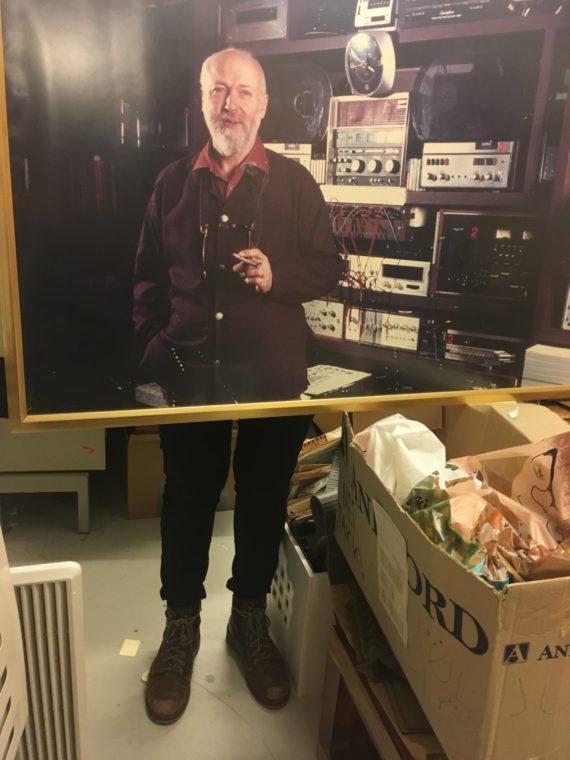On first impressions the Archive / Collection of European Classical Music by Arne Dorumsgaard at The Norwegian Institute of Recorded Sound in Stavanger is static, silent and fixed. The wider collection at the Institute is added to over time with donations and acquisitions, however the core of the collection is unchanged since its purchase for the nominal sum of 1 Krona in the 1980’s.
Over the course of 2 weeks in December 2018 and March 2019 I have been investigating the collection as Artist in residence for the NATUR project organised by Curated Place and hosted by ELEFANT in Stavanger.
The collection is of tremendous global importance, being one of the world’s largest collections of classical European music and, as a resource for research and anyone interested in music from this period it’s significance cannot be overstated. I believe it should be much more widely recognised in these fields than it currently is and I feel part of aim and outcome of the residency is to help with the promotion and visibility to a wider audience.
Within the first few days of my explorations I realised that it wasn’t the immense collection of 78, 45 and 33rpm Vinyl records that would form the basis of my own research and outcomes. I felt that although interesting, clearly important and an astounding achievement to have spent a life building this collection it was the life of the collector rather than his collection that fascinated me. I’m certain that there will have been countless scholars, researchers, hobbyists and enthusiasts who have pored over the works and lives of the composers, performers and singers contained within this archive: and I was struck by the thought that in our networked world with it’s endless possibilities for discovery of old and new music, whether in physical or digital form through various streaming platforms that many of the recordings would be accessible outside of the archive, and that far from being a dead end for investigation, I would be following along crowded pathways well trodden before me.
Fortunately the archive doesn’t just contain recorded and published music that can be accessed elsewhere! Alongside the huge collection of records Arne Dorumsgaard left the majority of his life’s work: recording equipment, catalogues, books photographs, recordings from the radio, Videos, cassette tapes, newspaper articles, restaurant menus and his Piano.
Rather like a child exploring their parents attic or basement storage space in search of unknown treasure I was absolutely thrilled to discover box upon box of old catalogues, hand written notes, strange manuscripts and receipts for everything from typewriters to Air conditioning systems. It was these items combined with discussions / interviews with the staff of the institute that began to bring this collection and it’s collector to life. I was fascinated for instance by the amount of tape recorders he owned (all stored in the basement of the archive) and discovered in conversation that he would record programmes broadcast on the radio across various channels – a bit like an analogue version of today’s home recording using a TIVO box. These programs may indeed be one of the most important parts of the collection as the recordings were often destroyed after broadcast by the radio station and therefore they may be the only existing recordings of particular, important classical performances.
If the Vinyl collection felt static, everything else – the collection of tapes, the recording equipment, ephemera and wider discussion concerning the archive felt dynamic and exciting. At some point in the future when the enormous task of cataloguing, documenting and disseminating the entire collection (which will take decades) is complete – it may also solidify.
In my own work I’m interested in what is often overlooked, things that exist below the surface and the everyday activities which lend poetry to life.
What if everything else, not the collection held the most promise? What about the sounds inside and surrounding the building, the noises of everyday activity and the stories of the people working with the archive?
These questions quickly formed the basis of my research, recordings and documentation of my residency.
I met the politician who campaigned to bring the collection to Stavanger. Discovered that Arne’s son Tejre is a member of the board and visited with him in Telemark to interview him about his life, find out more about his love of cooking and enjoy an incredible meal of confit duck. I recorded Iselin (The Archive Manger) playing a Steel pan drum in the basement of the archive, found out about Patricios (the librarian) desire to open a cabaret club, his classical music background and love of Grace Chan, discovered that Jaqueline teaches Akido and is known in Stavanger as Aikido Mama, Dj’d with records from the collection at a local coffee shop and learnt that Tom (Head honcho at ELEFANT) used to run a record label and now collects contemporary art. (More on these encounters and delicious diversions soon)
Through these adventures with the people connected to the archive I began to piece together more about Arne Dorumsgaard’s life, made new friends and formulated some ideas as to what the final outcomes of the project might be.














